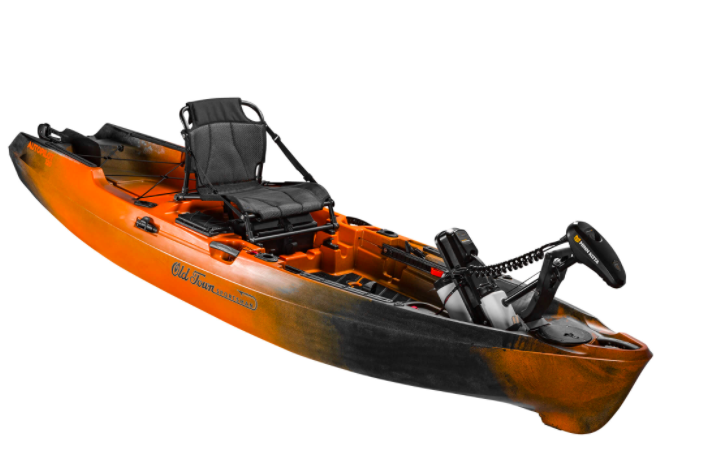

We may earn revenue from the products available on this page and participate in affiliate programs. Learn more ›

This story originally featured on Outdoor Life.
Sight fishing in shallow water is one of the most exciting ways to chase fish on inshore waters. Kayaks are ideal for fishing in such places. They have a stealthy hull and shallow draft, but some models are difficult to fish from while standing up.
It’s not a boat stability issue, but rather a wind problem. When you stand in a kayak, your body acts like a sail. You will catch any breeze and get blown off target. And the wind is always blowing when you’re fishing near the ocean.
The new Sportsman AutoPilot from Old Town aims to change this. It’s a large, stable kayak designed as a platform for a saltwater-grade through-hull Minn Kota GPS-enabled trolling motor with 45 pounds of thrust. You can control it with a remote (called a “i-Pilot”) that you wear around your neck.

The motor comes with GPS sensors and auto steering functions that let you follow a course, hold a position, and keep your bow on a heading, even in heavy winds and strong currents. Since you control all these functions with a handheld remote, you can maneuver your boat while standing, thereby opening up a whole new way to fish.

I tested this kayak in the back of a new inlet cut by Hurricane Sandy through a barrier beach on Long Island’s South Shore. Strong tidal currents there have since dumped several square miles worth of sand into the bay behind Fire Island, creating wide, shallow flats perfect for trying out the new platform.

The first thing I noticed about the AutoPilot was how little water it needed to maneuver. The kayak was built on a double-hull design that creates a deep cavity in the center of the boat. This fills with water as your weight presses down on the hull. Since the prop tucks partway up into this cavity, the motor draws less than you’d think. A buddy and I had to cross about a mile of water shallow enough that my friend (who was fishing from a Hobie kayak) had to kick up his fins and grab his paddle to cross. I was able to cross under battery power without ever having to pop up the motor.

The second thing I noticed was how stable the boat feels. The AutoPilot’s bow is very wide, with lots of floatation forward, making for a very secure standing platform. The fishiest places we found were along the sod banks to the east of the inlet, where the current had cut nice underhangs along the banks. I’m a big guy, pushing 250 pounds, and was able to comfortably cast around the clock despite a swirling 2-knot current and occasional breeze that would have grabbed the bow and spun the kayak around if the motor hadn’t been holding on a heading.

The AutoPilot’s auto steering and spot lock functions proved useful and reliable when sitting down, too. They made it easy and simple to counteract the wind when I was fishing jigs in deeper water. I also appreciated the ability to hold my position at the push of a button, which made re-rigging, putting fish on a stringer, and other complicated tasks a lot less work in heavy current.
Electric kayaks are great for covering ground without burning calories, but they do cost more and come with heavy batteries and motors that you have to lug up and down the beach if you’re not launching from a boat ramp. I’ve mostly stuck to pedal kayaks because they are lightweight, and more reliable because they are powered by me—not electronics.
But the AutoPilot gives you a unique and effective way to fish that you can’t get on other platforms. Once you figure out how to use the remote (which does take a few trips), you’ll feel like you’re out on the water with a guide poling you around. It also fishes well in bigger water, where the GPS motor keeps wind and current from pushing you off target. It’s still heavy and, at almost $3,800 it is definitely not cheap, but it’s a lot more portable, versatile, and less expensive than a flats boat.
